Patio Moss Mold and Mildew Prevention
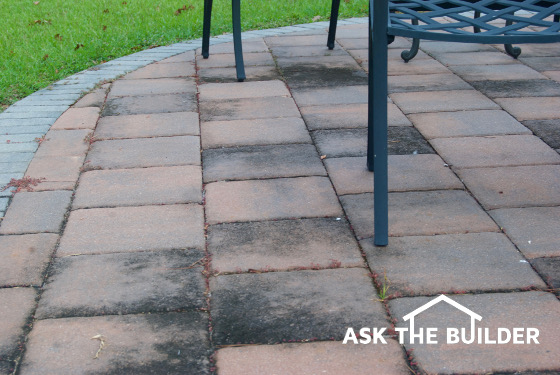
Patio Moss Mold and Mildew Prevention | This ugly black mold and mildew on the patio can be prevented with a simple spray-on solution! (C) Copyright 2022 Tim Carter
"Moss, mold, and mildew need food to survive, just like you and me. The food sources can be an assortment of things..."
Patio Moss Mold and Mildew Prevention Checklist
- Moss, mold, mildew, and algae feed off invisible food and water
- Pressure washing can damage precast colored pavers and brick
- WATCH the copper sulfate video below!
- Copper sulfate is the secret to STOP moss, mold, algae, and mildew on your patio
- CLICK HERE to Get Tim's FREE & FUNNY Newsletter!
DEAR TIM: My wife and I have an outdoor patio constructed with colored precast concrete paving blocks. It doesn’t take long each year for black mold and mildew to start to grow on it.
We also have an issue with moss and algae growing on it. I have to power wash it at least once a year and wonder if there’s a way to prevent the moss, mildew, and mold from growing in the first place.
Am I damaging my patio with the power washer? Why is it growing on the precast concrete pavers? This problem can’t be that hard to solve. Loren P., Okatie, SC
Related Links
Certified Organic Patio Cleaner
How to Remove Patio Algae Without Alien Help
DEAR LOREN: I used to have the same problem on two massive solid-clay brick paver patios in the back of the last house I lived in. It was a mind-numbing job that took hours and hours of work to restore the patio to brand-new condition each spring. I hated doing that job.
Why Does Patio Moss Mold Grow?
Let’s talk about why the moss, mold, and mildew grow in the first place. Many years ago, I couldn’t understand how it could grow on solid rock, precast concrete or brick, but now it’s crystal clear to me as I’ve attained more knowledge.
Moss, mold, and mildew need food to survive, just like you and me. The food sources can be an assortment of things just as we humans have countless different things we eat.
Dust, ultra-fine sugar aerosols from trees and bushes, tree sap, minerals, organic debris, etc. are all food sources for the unsightly things growing on your patio.
Free & Fast Bids
What is a Fast Test to Grow Mold & Mildew?
You can do a fast test that produces dramatic results by just pouring out a small amount of carbonated soda that contains sugar or high-fructose corn syrup on your patio. You might have mildew growing on the spill in as little as forty-eight hours if you do it in a shaded area of your patio.
Water is the only other missing ingredient needed to fuel the moss, mold and mildew since their spores are constantly falling down on your patio. If you could keep your patio completely dry, you’d not have any growth.
But even morning dew is enough to sustain the green and black organisms. They’re tenacious and know how to make a little water go a long way.
Will Power Washing Damage My Patio?
Let’s discuss power washing. There’s a raging debate in the home improvement community about whether or not power washing can be destructive to concrete, brick, precast pavers, wood, etc. The unequivocal answer is yes - it’s destructive.
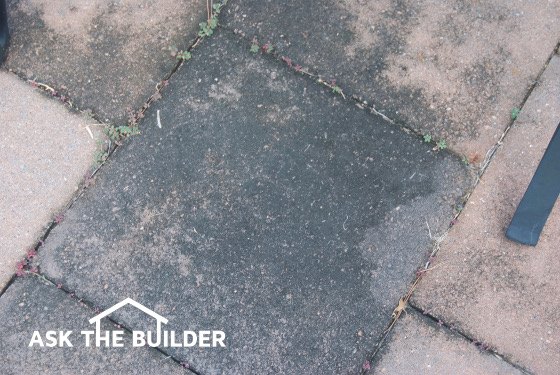
©20122 Tim Carter
The rate of destructive force is directly proportional to the pounds-per-squares-inch (psi) power the machine delivers, the angle of the spray-wand tip and the distance the tip is from the surface being cleaned. You just have to look at the Grand Canyon to understand that water simply flowing over rock can do damage.
Water directed at a surface with 1,500 psi or more can do immense damage on softer surfaces and it does cumulative damage to harder surfaces with each successive washing.
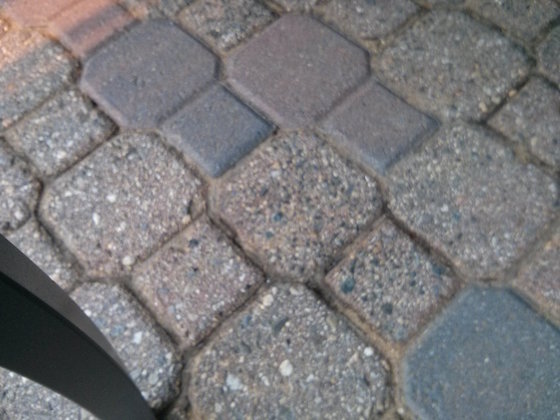
Here's a great example of concrete paving brick ruined by pressure washers. You can see the aggregate in the concrete. The brand new ones have not yet lost the colored cement paste off the sand and gravel. Copyright 2022 Tim Carter
Will High Pressure Remove Colored Cement?
In your case power washing will rapidly remove the colored cement paste that covers the small sand and gravel particles in your precast pavers. If you had a saved paver in your garage that the installer left behind that’s never been washed or exposed to the elements you’d notice that it’s got a uniform color over the entire surface.
This uniform color is created by an ultra-fine layer of pigmented Portland cement that coats the sand and small gravel in the pavers.
After one or more washings, you’ll start to notice the individual colors of the different sand and gravel that was used to make the pavers. The colored cement will still be there between the individual particles of sand and gravel.
How Do You Prevent Patio Moss Mold Growth?
The good news is you can prevent the growth of patio moss, mildew and mold. All you have to do is borrow technology developed hundreds of years ago by mariners.
Clipper ships and warships that depended on speed to make money and win wars employed the use of copper plates on the hulls of the ships so barnacles and other marine life would not grow on the wood below the water line.
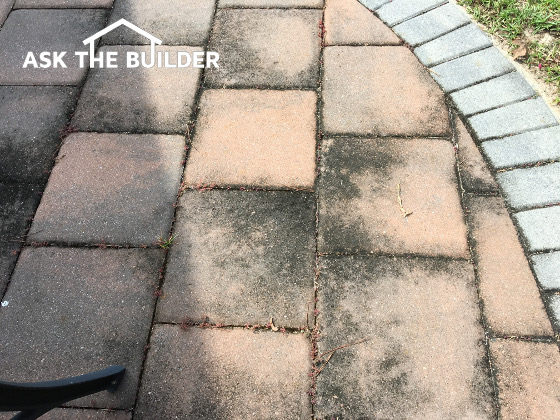
Patio moss mold can be prevented using copper sulfate. ©2022 Tim Carter
Is Copper a Natural Biocide?
Copper is a natural biocide. It’s pure, it’s pretty much harmless to mammals and it’s found in multi-vitamins that you might take to stay healthy. Copper in our bodies helps us to retain iron and it aids in producing the energy you need to get through the day.
You can’t cover your patio with copper sheets, but you can spray on a liquid solution of copper that will soak into the top surface of the concrete pavers. This copper will stop the growth of the pesky green and black organisms in their tracks.
Do You Dissolve Copper Sulfate In Water?
The easiest way to apply the copper is to purchase copper sulfate crystals. This is readily available online and the blue crystals dissolve readily in warm or hot tap water.
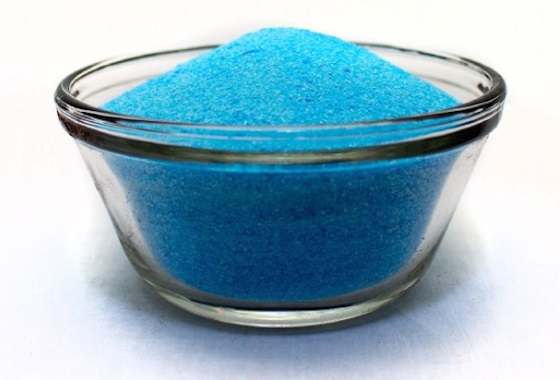
This is copper sulfate. It dissolves easily in water. Spray it on with a hand-pump sprayer. CLICK THE IMAGE ABOVE TO ORDER THE COPPER SULFATE NOW.
You can mix up to 1.75 pounds of copper sulfate in each gallon of water. This will create a very saturated solution. This much copper can be harmful to nearby vegetation, so just apply the solution to the top surface of the stone. My guess is you’ll discover that two or three gallons of water is plenty to treat the average-sized patio.
You can cut down the concentration to about 1 or 2 ounces of copper sulfate per gallon of water. Test it to see if it's strong enough.
Copper Sulfate Video
Watch this funky video about copper sulfate. This guy is spot on with his advice!
Is it Best to Apply To Dry Pavers, Concrete or Brick?
I’d apply the solution when the patio is dry as a bone. You want the solution to soak into the surface. Concrete is absorbent unless it has a shiny steel-troweled finish.
Most exterior concrete is rough, so the solution will soak in. Apply just enough so the pavers get nice and wet, but not so much as the solution runs off into surrounding vegetation. You don’t want to poison expensive landscaping nearby.
How Often do I Apply The Copper Solution?
You’re going to have to periodically re-apply the copper sulfate solution because normal rainwater will leach the copper back out of the pavers. I can’t tell you how often because it’s a function of the amount of rainfall where you live. But I do know it’s far easier to apply this solution in minutes rather than bend over for hours and hours using a power washer!
Column 1215
32 Responses to Patio Moss Mold and Mildew Prevention